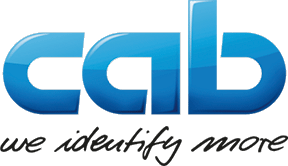Marking and manufacture of electronics
Labeling electronic components uniquely

Electronic components in general and printed circuit boards (PCB) in particular are widely identified using very small labels, with imprinted codes detected by automatic machines. Spaces to apply labels are limited on PCB, so low tolerance labeling systems are required. HERMES Q devices are capable of applying labels as small as 4 x 4 mm.
They also provide high flexibility. To apply printed labels, a HERMES Q print unit can be combined with different applicators. Stroke applicators 4114 and 4414 have proven to be effective with electronic components. Printed labels are picked up by a pad module. Stroke cylinders power the pad move to its target position and apply the labels. On a 4414 applicator, labels can be spotted exactly in directions x and y. If operations change, the applicator can be replaced easily.
On this topic:
Video: PCB labeling using a 4114 applicator
Videos: labeling electronic components using a 4414 applicator
Marking round materials with shrink sleeves and flag labels

Shrink tubes have proven worthy in electrical cabinet construction, in automation or insulation of defective spots on cables or pipes. The plastic tubes contract under heat. Objects which are encased by shrink tubes are electrically insulated and protected from mechanical damage. cab provides printers designed for shrink tube labeling with a centered material guidance. When printing with a suitable SQUIX device, to protect from electrostatic charge, cab manufactures its entire casing conductive if required. A conductive hinged cover with the inclusion of the upper plate of the printer is a spare part.
 Labels intended to be processed automatically by a cab flag applicator on cables or slim pipes, are optimized. Serial numbers or barcodes can be printed on labels and the labels be fold around cables. Wrap-around labels are a good choice if instructions for use or other small texts must be attached to small cylindrical containers.
Labels intended to be processed automatically by a cab flag applicator on cables or slim pipes, are optimized. Serial numbers or barcodes can be printed on labels and the labels be fold around cables. Wrap-around labels are a good choice if instructions for use or other small texts must be attached to small cylindrical containers.
On this topic:
Video: Printing and cutting shrink tubes
Video of a Hermes printer operating a flag applicator
Guide to label applications (PDF; 6.2 MB)
Secure data

No later than integrating components to a network, when administration and authentication are required, the protection of personal data becomes a key issue. cab label printing systems provide all common protocols to protect data in a network.
On this topic:
cabPROTECT: Data security in label printing
How to identify electronic devices

Modern electronics manufacture facilities have to meet high requirements. For example, labeled coding provides traceability to where a part was originally manufactured and which value-added or logistics chains it has passed. Data recorded during quality assurance must be evaluated and made available for subsequent documentation.
In cases of metal or plastic products be marked permanently, fiber lasers are particularly economical. They enable safety instructions, technical or other data be marked directly on electronic devices. cab’s high-quality XENO marking lasers are for universal use: desktop devices, systems to integrate in fully automatic production, protective housings provided for marking single parts or small series, type plate marking, or laser-markable foil labeling.
On this topic:
Overview of laser marking systems
Attention! Sensitive technology!
Assembled PCB enable control and regulate electronic machines, drives and devices. Thus, demands are strong. In the matter of fully automated manufacture, the separation of assembled units off a raw material is a standard discipline, so is transport. cab has many years of experience in these sectors as well. Proven equipment keeps sensitive components intact even in case of electrostatic discharge.
Precise PCB separation

In terms of thickness, PCB range in millimeters. Separation means significant mechanical stress. Resistors, microcontrollers and condensers, assembled close to the milled groove on little space, might be damaged. cab devices of the MAESTRO series have been developed for low-stress separation.
With a MAESTRO 4S, a milled groove can be traversed by the circular blade several times – special blade settings provided, even PCB made of aluminum. By traversing twice (with the blade distance readjusted by motor), stress is already further reduced. High-quality cut-offs improve PCB quality significantly. Separation lengths up to 600 mm can be set continuous.
On a MAESTRO 5L, up to 15 PCB can be arranged next to each other, to be separated simultaneously. Separated PCB are deposited to an integral conveyor belt. The MAESTRO 6 has been designed for applications using extra-long materials up to 1,500 mm in length.
On this topic:
Explanatory videos of MAESTRO 4S separating PCB
Safe PCB transport

The latest assembly plants must adapt to individual needs several times a day. To transport PCB of different sizes, magazines must be adjusted consecutively. Depending on the magazine, widths are set using screw clamping or a toothed belt, the latter been adjusted by hand or by a motor.
cab series 800 magazines provide a coupling. When inserting a magazine onto a loader in an assembly plant, the flange on the servo motor of the loader connects to the coupling. The flexible side wall of the magazine moves on threaded spindles with uniform precision to a reference spot. Parallelism is provided. Then the magazine automatically adjusts to the width of the PCB specified by the plant control. There is no need for providing pre-adjusted magazines on stock. Human errors are avoided, with processes of higher quality as a result.
On this topic:
SEW Eurodrive sample case, South Germany
Endress+Hauser sample case, South Germany
February 2021

